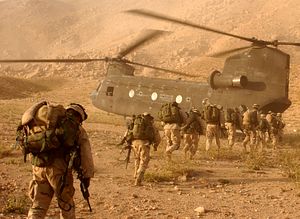Recently, it has emerged in a report that the United States has spent more on reconstruction efforts in Afghanistan than it spent on the Marshal Plan, which resuscitated Europe after the Second World War.
According to the U.S. Special Inspector General for Afghanistan Reconstruction (SIGAR), congressional appropriations for reconstruction in Afghanistan have reached $109 billion in today’s dollars. On the other hand, the Marshall Plan delivered $103 billion in today’s dollars to 16 European countries between 1948 and 1952. However, reports comparing reconstruction efforts in Afghanistan and the Marshall Plan do not generally take into account the fact that the Marshall Plan appropriations constituted a much greater proportion of the U.S. economy in the 1940s than Afghanistan reconstruction efforts do today. While the U.S. has spent $109 billion out of a $13-15 trillion economy on Afghanistan over 13 years, in 1948-1952, it spent $103 billion out of a $2 trillion dollar economy (adjusted) in only four years.
Nonetheless, the fact that the U.S. spent so much money on Afghanistan while getting so little from its efforts shows that many obstacles must yet be overcome for Afghanistan to fully stabilize. More than half of the money, $62 billion has been spent on building up the Afghan military, which essentially had to be built from scratch. The Marshall Plan, on the other hand, aided the economies of European countries and not their militaries directly.
Unfortunately, much of the American money in Afghanistan has been misspent or thrown at projects without first judging their viability or necessity. For example, a $2.89 million storage facility has gone unused for over a year. This goes to show that the U.S. solution of throwing money at problems, both domestically and internationally, has its limitations. Using money effectively to come up with desired outcomes is more important than spending large amounts of it on token projects.
Major worries regarding the Afghan army include lax oversight of weapons, many of which cannot be tracked, and which could find their way to the Taliban. More importantly, an army’s effectiveness or lack thereof often comes down to morale and discipline, factors that extend beyond how much money it gets. Emphasizing morale and discipline, so that the Afghan army does not go the way of some Iraqi units in northern Iraq, involves local, tribal and social factors in Afghanistan. These are not simply matters of pay. Additionally, the solution to Afghanistan’s security issues will need the cooperation of Pakistan, which is a political issue.
The report’s findings also go to show that decisions on how to spend money are best made by people on the ground with detailed knowledge of the needs of Afghanistan instead of being made by planners in the U.S. One of the most glaring examples of mistakes made by U.S. planners involved the U.S. Department of Agriculture spending $34.4 million towards a soybean project in the face of evidence that the crop was “inappropriate for conditions and farming practices in northern Afghanistan, where the program was implemented.”
Ultimately, Afghanistan has to do more to strengthen itself and its weak state. The Afghan state’s anticipated revenue this year is $2.8 billion while its expenditures will be $7.6 billion. Consequently, it will be dependent on foreign aid for years to come as it struggles to increase its revenue. Admittedly, this is difficult in a state that has little presence in many parts of the countryside and in a country where few people actually pay their taxes. Nonetheless, it is imperative that Afghanistan gradually increase its revenue base while finding ways to use the money it has more effectively.
The Pentagon has estimated that Afghan forces will require 370,000 people, which will cost more than three times as much as the Afghan government’s entire domestic revenue. Given this fact, in a country where a strong nation state has not yet fully taken hold, both Afghan and U.S. figures should be open to the idea of talking to tribes and militias and using them as a supplement to the national army in order to improve stability. Although risky, manipulating and playing different groups against each other is a skill that is necessary for the success of Afghanistan and one that any successful leader of the country must have in order to survive, as Afghan President Hamid Karzai pointed out.
Perhaps the U.S. spent so much money to little avail in Afghanistan because it channeled its efforts through ineffective and little-trusted state institutions in a country where the state has not been fully accepted and implemented as the dominant form of political organization. As Jennifer Brick Murtazashvili notes over at Foreign Policy, Karzai is correct in arguing that Afghan citizens feel closer to and trust traditional authorities more than state institutions. Customary authority is more likely than state building to ensure development and stability for Afghanistan. One should remember that it took many European countries hundreds of years to evolve state institutions out of complex feudal structures, so it is naïve to expect otherwise of Afghanistan.

































